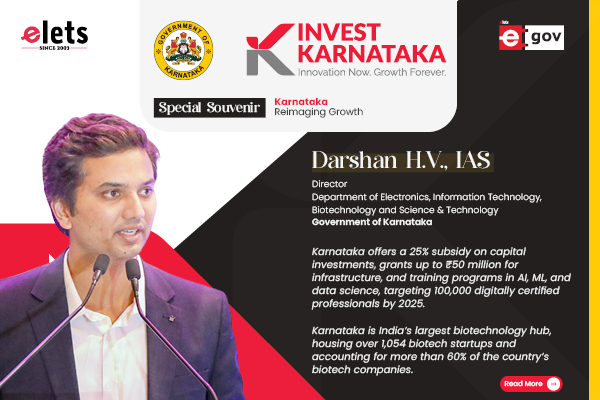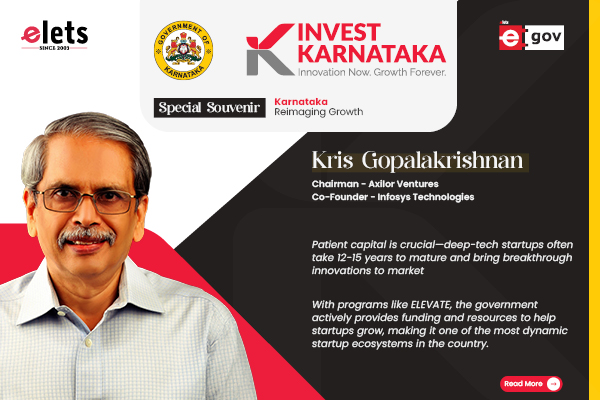
India’s digital landscape is undergoing a rapid transformation as the Ministry of Electronics and Information Technology (MeitY) sets its sights on building a $1 trillion digital economy by 2025-26. With transformative initiatives aimed at bridging the digital divide and fostering inclusive growth, MeitY is leveraging cutting-edge technologies—such as artificial intelligence, IoT, and blockchain—to revolutionize sectors, including e-governance, fintech, agriculture, and healthcare. Sanket Bhondve, IAS, Joint Secretary, Ministry of Electronics and Information Technology (MeitY), shares more in an exclusive interview with Nijhum Rudra of Elets News Network (ENN).
Edited excerpts:
How do you envision India’s technological transformation over the next five years?
Over the next five years, India is poised to become a global leader in technology and innovation, targeting a $1 trillion digital economy by 2025-26. This transformation will be driven by the widespread adoption of emerging technologies like Artificial Intelligence, IoT, and blockchain, alongside the expansion of digital infrastructure. Key focus areas include enhancing e-governance, promoting fintech, revolutionizing agriculture through agritech, and ensuring inclusive growth by bridging the digital divide. The goal is to create a digitally empowered society where technology drives economic growth, improves public service delivery, and enhances the quality of life for all citizens.

What are the key initiatives being undertaken by MeitY to improve digital infrastructure across rural and underserved regions of India?

MeitY is spearheading several initiatives to bridge the digital divide in rural and underserved areas. The BharatNet project aims to connect 2.5 lakh gram panchayats with high-speed broadband, with over 1.94 lakh already connected. Through Common Service Centres (CSCs), we have established over 5 lakh digital service delivery points in rural areas, offering services like banking, healthcare, and education.
Additionally, the PM-WANI initiative is creating a robust ecosystem of public Wi-Fi networks to ensure affordable and accessible internet connectivity in remote regions. These efforts ensure that no citizen is left behind in India’s digital journey.
How is MeitY ensuring that digital infrastructure, such as broadband and internet access, is accessible to all citizens, especially in remote areas?
MeitY is committed to making digital infrastructure accessible to all, particularly in remote areas. Under BharatNet Phase II, we are expanding high-speed broadband connectivity to every village in the country. The Universal Service Obligation Fund (USOF) has already provided mobile connectivity to over 1.2 lakh villages, ensuring that even the most remote areas are covered. Additionally, India’s affordable data prices, among the lowest in the world at approximately $0.17 per GB, have played a significant role in increasing internet penetration. These measures ensure that every citizen, regardless of location, can access the benefits of digital technology.
Also Read | India’s Rapid IT Revolution: Leading the Global Digital Landscape
What is the volume of ICT you have deployed in improving government services? Can you highlight some case studies?
MeitY has deployed ICT at a massive scale to transform government service delivery. The UMANG app provides access to over 1,700 government services to more than 13 crore users, making it a one-stop solution for citizens. DigiLocker, with over 150 million users, has digitized 5.7 billion documents, reducing the need for physical paperwork. Aadhaar, with over 1.3 billion enrollments, has revolutionized identity verification and enabled the seamless delivery of welfare services. Case studies like eSanjeevani, which has facilitated over 10 crore teleconsultations, and e-NAM, which has integrated agricultural markets across the country, demonstrate the transformative impact of ICT in governance.
What is the growth you have witnessed in digital India initiatives by MeitY? In which areas are you currently working to offer a seamless e-governance solution?
The growth of Digital India initiatives has been phenomenal. For instance, UPI recorded 11.76 billion transactions in October 2023 alone, showcasing the rapid adoption of digital payments. We are currently focusing on areas like healthcare (eSanjeevani), education (DIKSHA), and agriculture (e-NAM) to provide seamless e-governance solutions. The integration of services through platforms like India Stack and API-driven ecosystems ensures that citizens can access government services efficiently and transparently. We aim to make governance more citizen-centric, accessible, and responsive.
How is MeitY facilitating the integration of various government services onto digital platforms to ensure ease of access for citizens?
MeitY is driving the integration of government services through platforms like API Setu, which enables interoperability between departments. The National e-Governance Plan (NeGP) has integrated over 3,000 services across states, ensuring a unified approach to service delivery. Initiatives like One Nation, One Platform, such as GSTN and eCourts, are streamlining processes and reducing redundancy. By creating a cohesive digital ecosystem, we are ensuring that citizens can access services seamlessly without having to navigate multiple platforms or departments.
Also Read | India’s Digital Transformation: The JAM Trinity and Beyond
How is MeitY leveraging emerging technologies like Artificial Intelligence and machine learning to improve public service delivery and governance efficiency?
MeitY is actively leveraging AI and ML to enhance governance and public service delivery. In healthcare, AI-powered tools are being used for TB detection and COVID-19 prediction, significantly improving diagnostic accuracy. In agriculture, AI-based solutions are helping farmers with crop yield prediction and pest control, boosting productivity. Additionally, AI-driven chatbots like MyGov Assist are streamlining citizen grievance redressal, ensuring faster and more efficient responses. These technologies are not only improving efficiency but also making governance more proactive and citizen-friendly.
| Note: Sanket Bhondve is an IAS officer with over 17 years of experience in governance, IT, policy formulation, and social sector projects. He currently serves as Joint Secretary at MeitY, Government of India, overseeing digital governance policies and key MeitY organizations. He played a key role in developing India’s Data Center ecosystem and managing Section 69A to curb social media misuse.
Previously, Shri Bhondve was Deputy Secretary at MoRTH and Private Secretary to Minister Shri Nitin Gadkari, contributing to the Bharatmala Pariyojana project to develop 34,800 km of highways. He has held various administrative roles in Madhya Pradesh and received six national and ten state-level awards, including the President’s Medal, for three consecutive terms. Shri Bhondve is also recognized for his work in improving the welfare of marginalized groups, reducing mortality rates, and initiating the “Model Day Care Centre” for senior citizens in Ujjain. He is currently focused on integrating technology for the differently-abled. |
Be a part of Elets Collaborative Initiatives. Join Us for Upcoming Events and explore business opportunities. Like us on Facebook , connect with us on LinkedIn and follow us on Twitter, Instagram.
"Exciting news! Elets technomedia is now on WhatsApp Channels Subscribe today by clicking the link and stay updated with the latest insights!" Click here!














